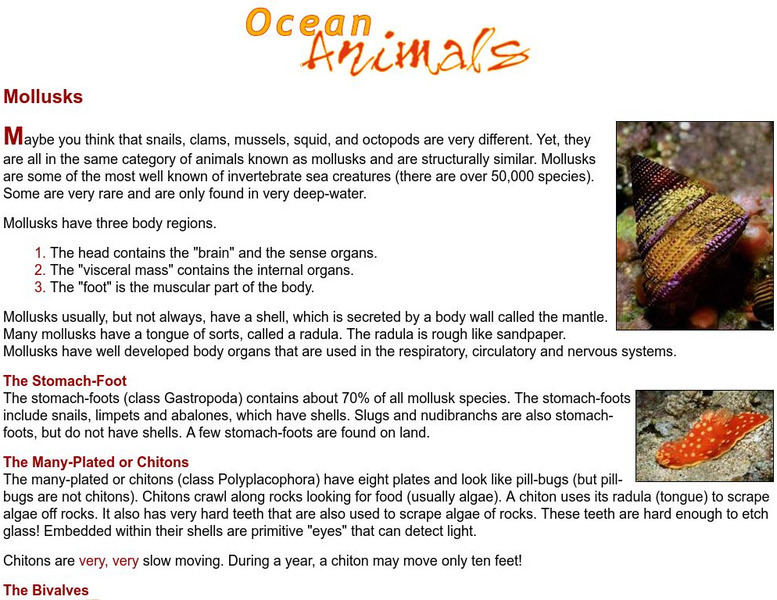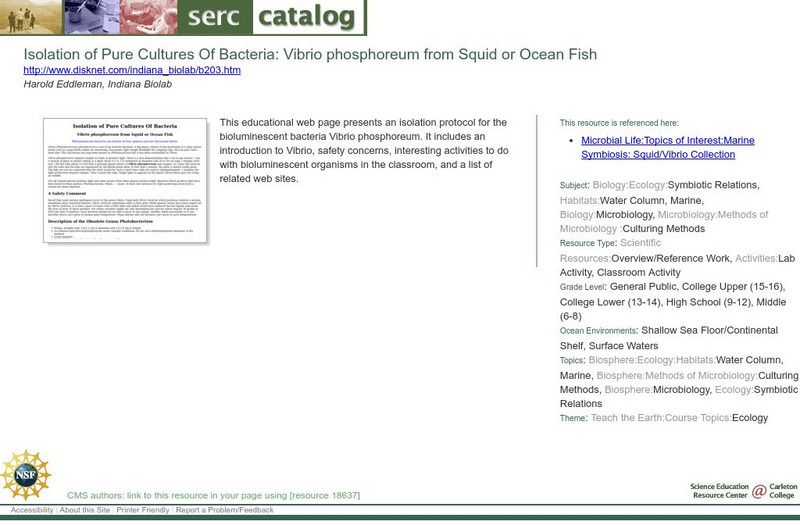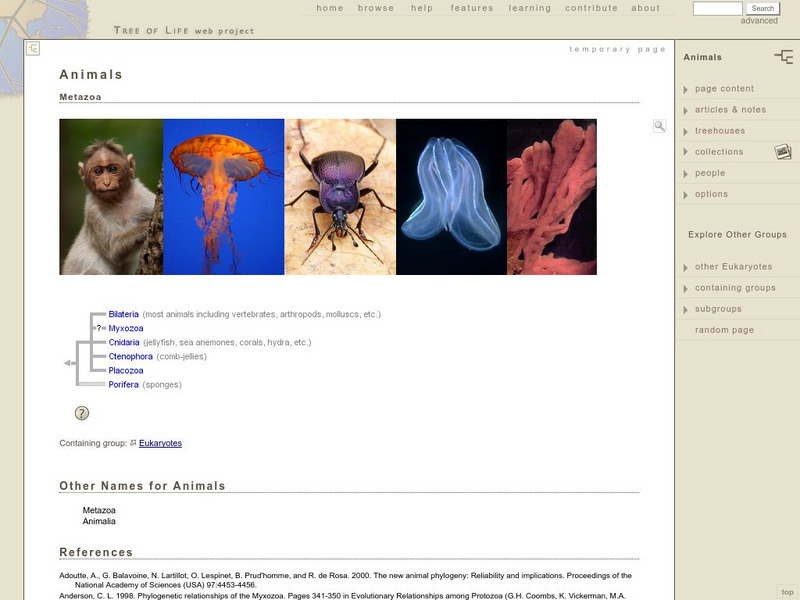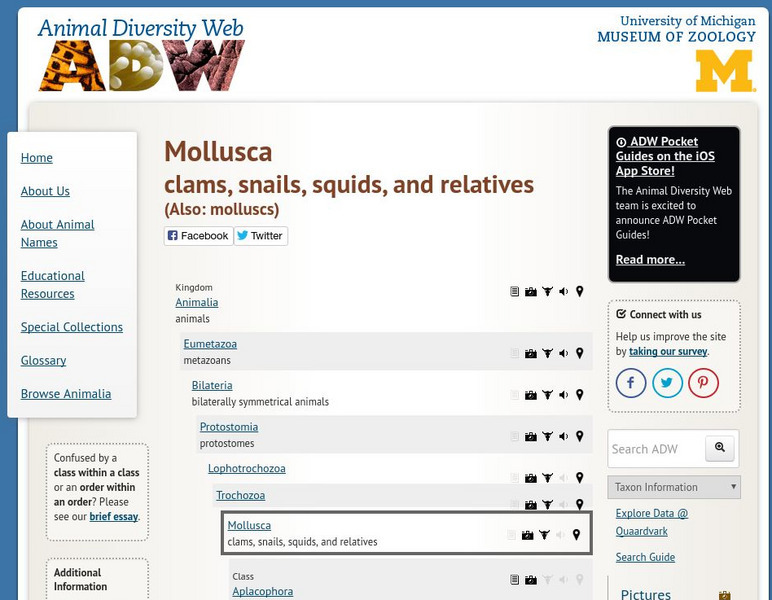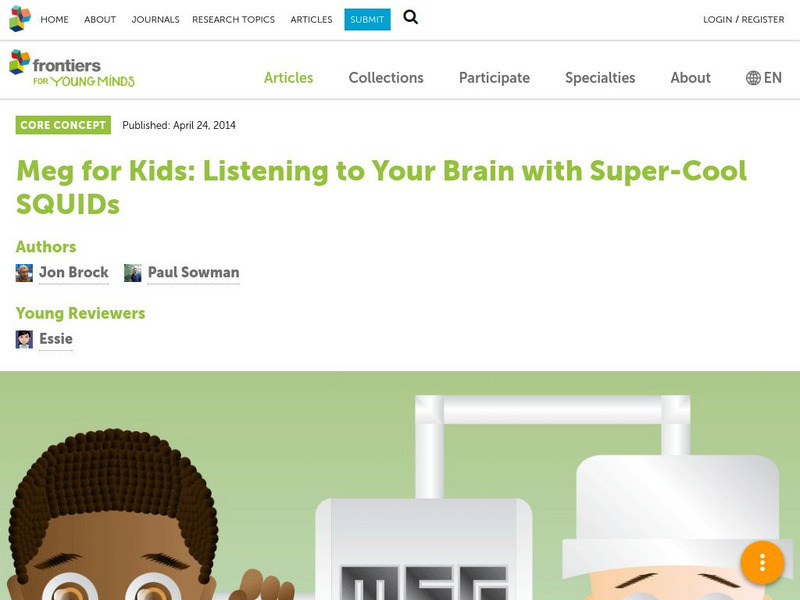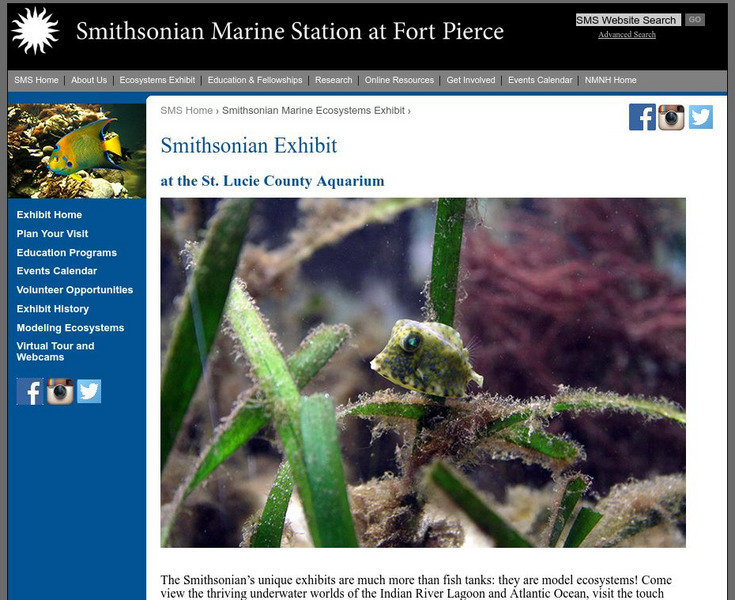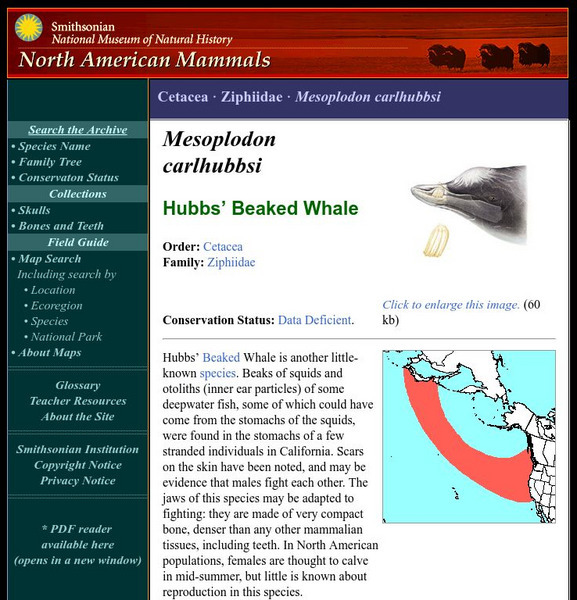Regents of the University of Michigan
Animal Diversity Web: Class Cephalopoda
The Animal Diversity Web provides a general overview of the diverse group of cephalopods, including octopus, squid, nautilus, and cuttlefish.
PBS
Pbs: Nature: Encountering Sea Monsters
An extensive amount of information is featured in this PBS site on Cephalopods. Images, videos, books, and web links are just a few of the items that can be found here.
Missouri Botanical Garden
Missouri Botanical Garden: Ocean Animals: Mollusks
The Missouri Botanical Garden describes the characteristics and natural history of mollusks in text and color photography.
Curated OER
Red Octopus on Squid Eggs
Twenty great pictures of octopi from California. This site also offers up close pictures of invertebrates, squids, and tidepools.
Curated OER
Octopus on Squid Eggs
Twenty great pictures of octopi from California. This site also offers up close pictures of invertebrates, squids, and tidepools.
Curated OER
Red Octopus on Squid Eggs
Twenty great pictures of octopi from California. This site also offers up close pictures of invertebrates, squids, and tidepools.
Other
Black Hills Institute of Geological Research, Inc.: Ammonoids
Ammonoids, more commonly referred to as Ammonites, are the extinct ancestors of today's octopus, squid and nautilus. This page provides excellent information about these creatures, as well as diagrams and pictures.
Globio
Glossopedia: Rockhopper Penguins
Rockhopper penguins live in steep, rocky places. The only way they can get around on land is to hop from rock to rock. Rockhoppers grow about 46 cm tall - almost as high as an adult's knee. They are the smallest of the crested penguins....
Tramline
Tramline, Inc.: Virtual Ocean Field Trip
In this enchanting site, students will learn basic principles about oceans and will be introduced to an assortment of sea life, both plant and animal. Other interesting ocean links can be found on the teacher resource section of this link.
Science Education Resource Center at Carleton College
Serc: Isolation of Pure Cultures of Bacteria
A web page that gives activities for use of bioluminescent organisms in the classroom. Specifically on the page is "an isolation protocol for the bioluminescent bacteria Vibrio phosphoreum".
Tree of Life Project
The Tree of Life Web Project: Animals
Extensive site that contains much information about the various animal phyla. Each phyla gives photos, common examples, scientific names and references. Collection of 1630 websites about bio-diversity.
Other
Native Planet: Dangerous Sea Life
Learn about venomous fish and other animals with the ability to inject venom, such as jellyfish and other venomous invertebrates.
Regents of the University of Michigan
Animal Diversity Web: Phylum Mollusca (Mollusks)
A great, detailed description of mollusks. Discusses parts of their external and internal anatomy and their functions, and lists several characteristics of mollusks. Tabbed pages include pictures, specimens and classification.
CK-12 Foundation
Ck 12: Biology: Mollusks
[Free Registration/Login may be required to access all resource tools.] Discusses characteristics of mollusks.
Other
Octopus of California
Twenty great pictures of octopi from California. This site also offers up close pictures of invertebrates, squids, and tidepools.
Language Guide
Language Guide: Los Animales Del Mar (Spanish)
This resource provides colorful pictures of sea animals interact with audio and the written vocabulary word as you move your mouse over the picture. This vocabulary would compliment a science unit on marine life.
Scholastic
Scholastic: Fractured Fairy Tales and Fables With Jon Scieszka
In this resource students will have an opportunity to learn about fractured fairy tales and fables with the help of Jon Scieszka. This site also features a writer's workshop where students can write their own fractured tale and publish...
Frontiers Media
Frontiers: Meg for Kids: Listening to Your Brain With Super Cool Squi Ds
Inside your brain, you have over 80 billion neurons - tiny brain cells, all working together to make you the person you are.Neurons talk to each other by sending electrical messages. Each message creates a tiny magnetic field. If enough...
Biology Pages
Kimball's Biology Pages: Animal Circulatory Systems
This page has information on different types of animal circulatory systems. Scroll to the bottom of the page to find out about mammals.
Smithsonian Institution
Smithsonian Marine Ecosystems Exhibit
Take an online tour of the Smithsonian's "Exploring Marine Ecosystems" exhibit. Learn about coral reefs and look behind the scenes as scientists maintain the model ecosystems.
Other
Sea and Sky: Mollusks
This illustrated article describes several different types of reef mollusks ranging form snails and clams to the chambered nautilus.
Enchanted Learning
Enchanted Learning: Sperm Whale
This clear and concise resource on sperm whales includes a diagram and information on its diet and echolocation.
Smithsonian Institution
National Museum of Natural History: American Mammals: Hubbs's Beaked Whale
Hubbs's beaked whale is another little-known species. Beaks of squids and otoliths (inner ear particles) of some deepwater fish, some of which could have come from the stomachs of the squids, were found in the stomachs of a few stranded...
Smithsonian Institution
National Museum of Natural History: American Mammals: Pacific White Sided Dolphin
Before the United Nations established a moratorium on the use of high seas drift nets in 1993, Pacific white-sided dolphins were frequently caught in the nets of Japanese and Korean squid fisheries. Today the species is better protected,...
Other popular searches
- Dissecting a Squid
- Giant Squid
- Vampire Squid
- Squid Dissection
- Photograph of Giant Squid
- Giant Squid Facts
- Squids Will Be Squids
- Colossal Squid Food Chain
- Colossal Squid
- Squid Dichotomous Key
- Squid Experiments
- Dissecting a Squid Diagram


